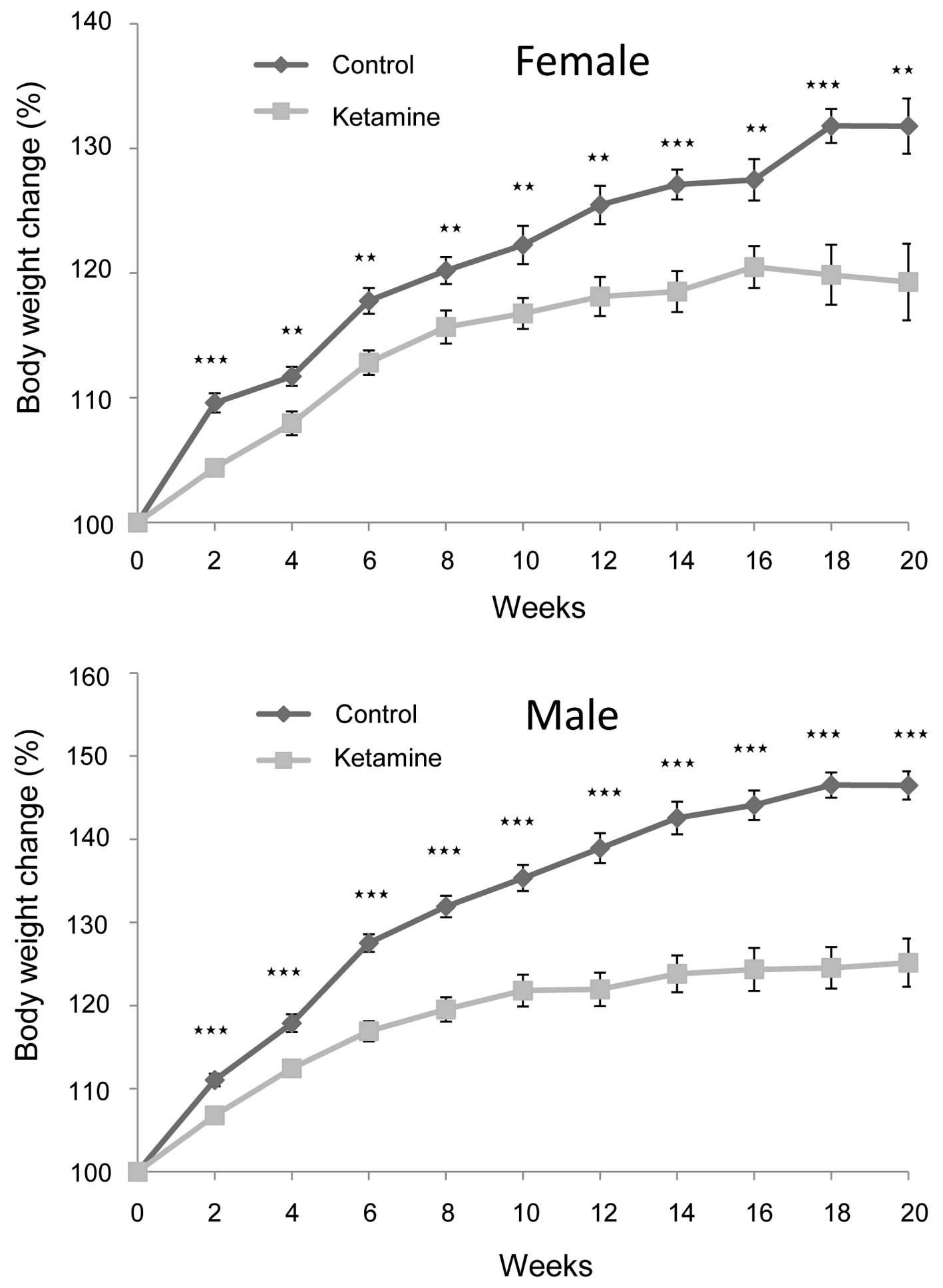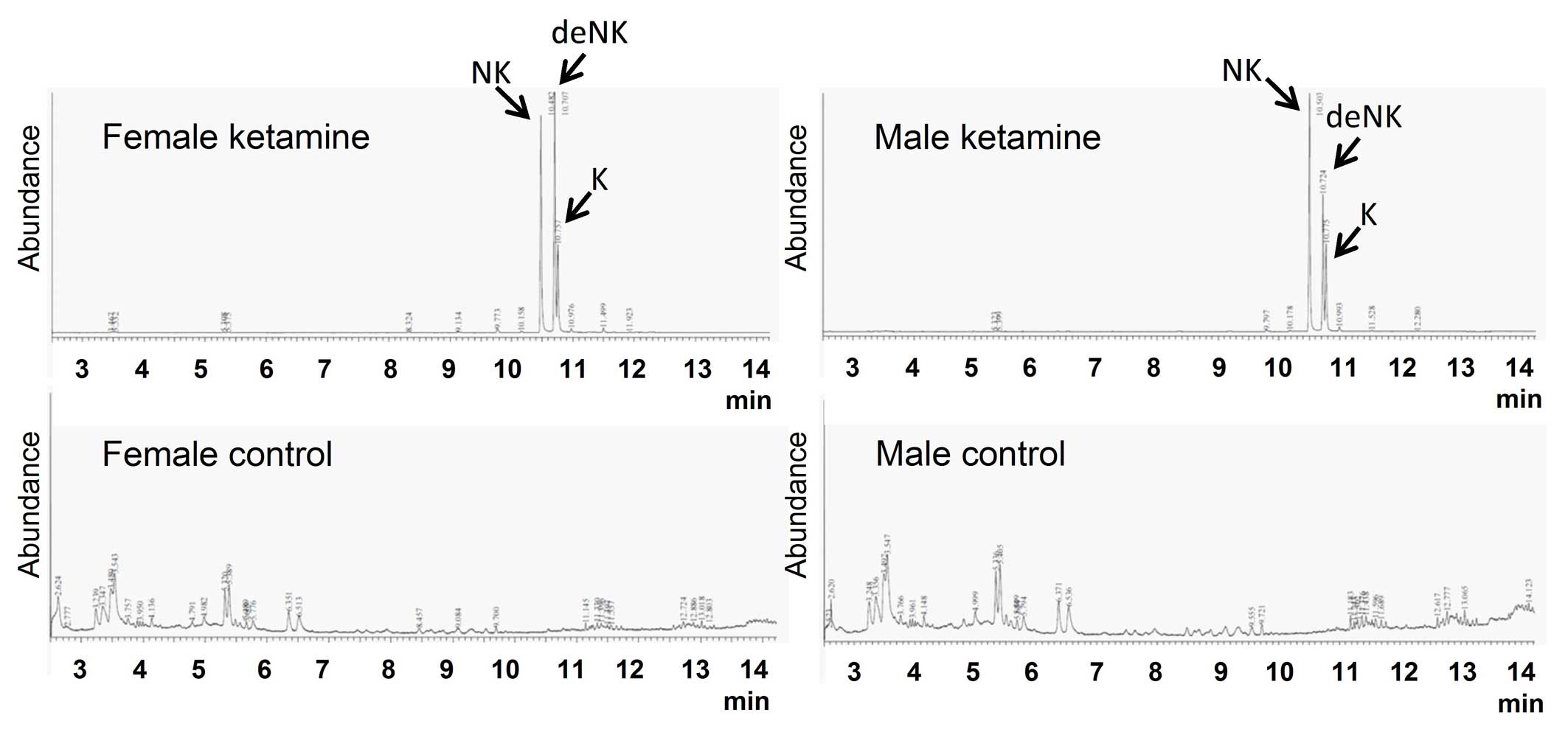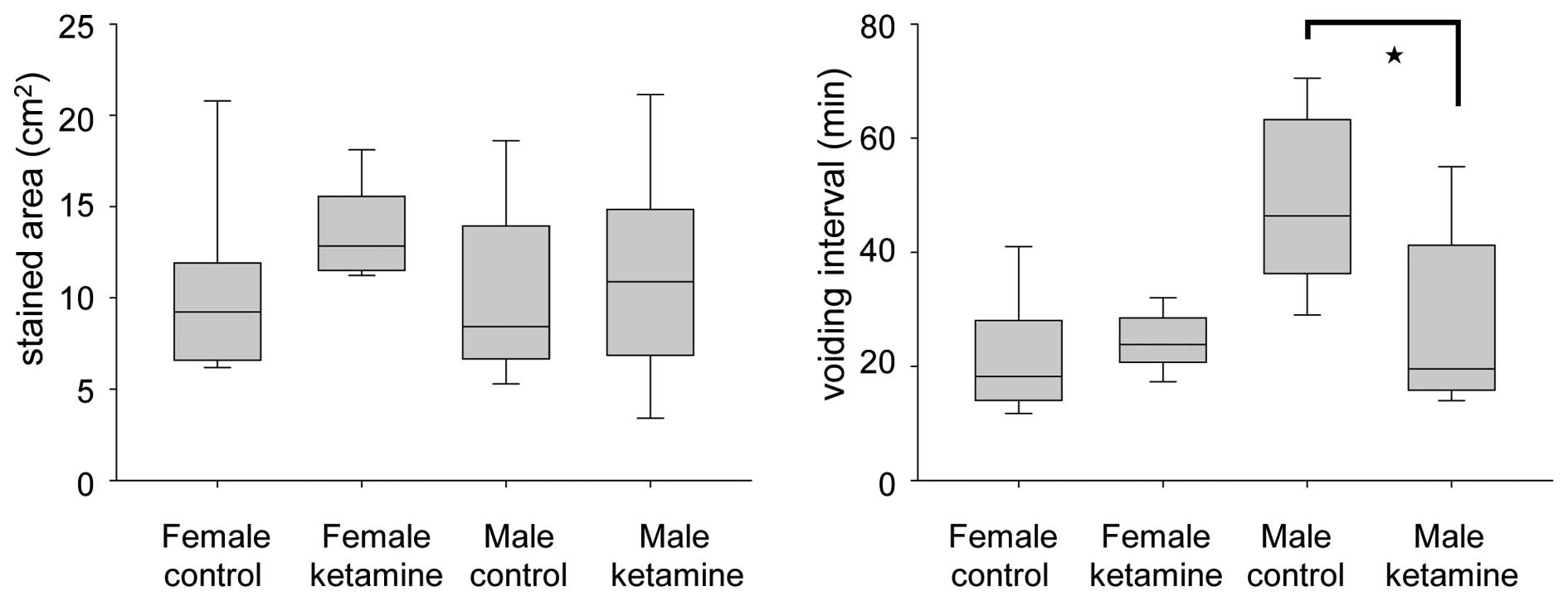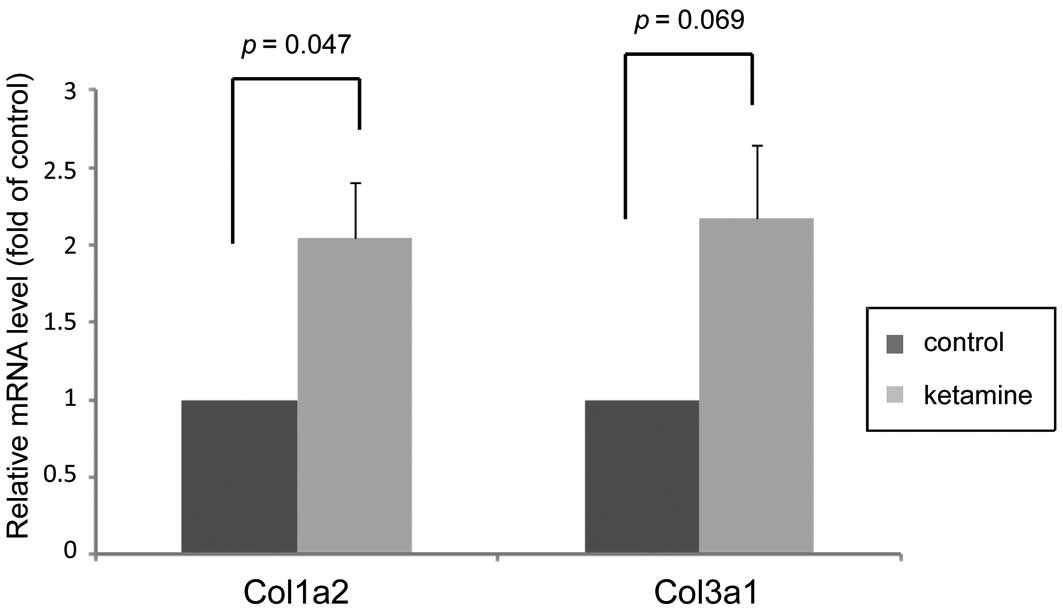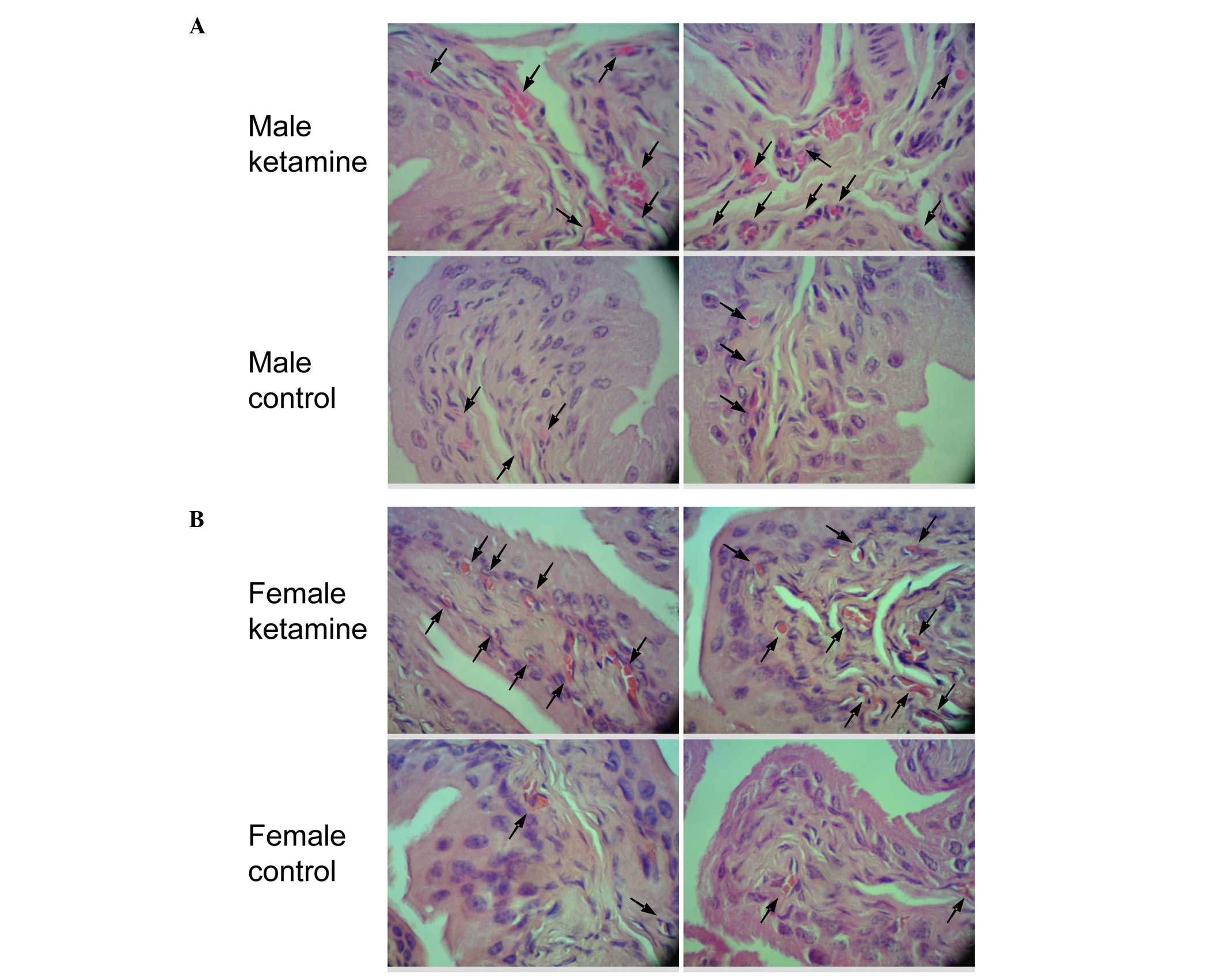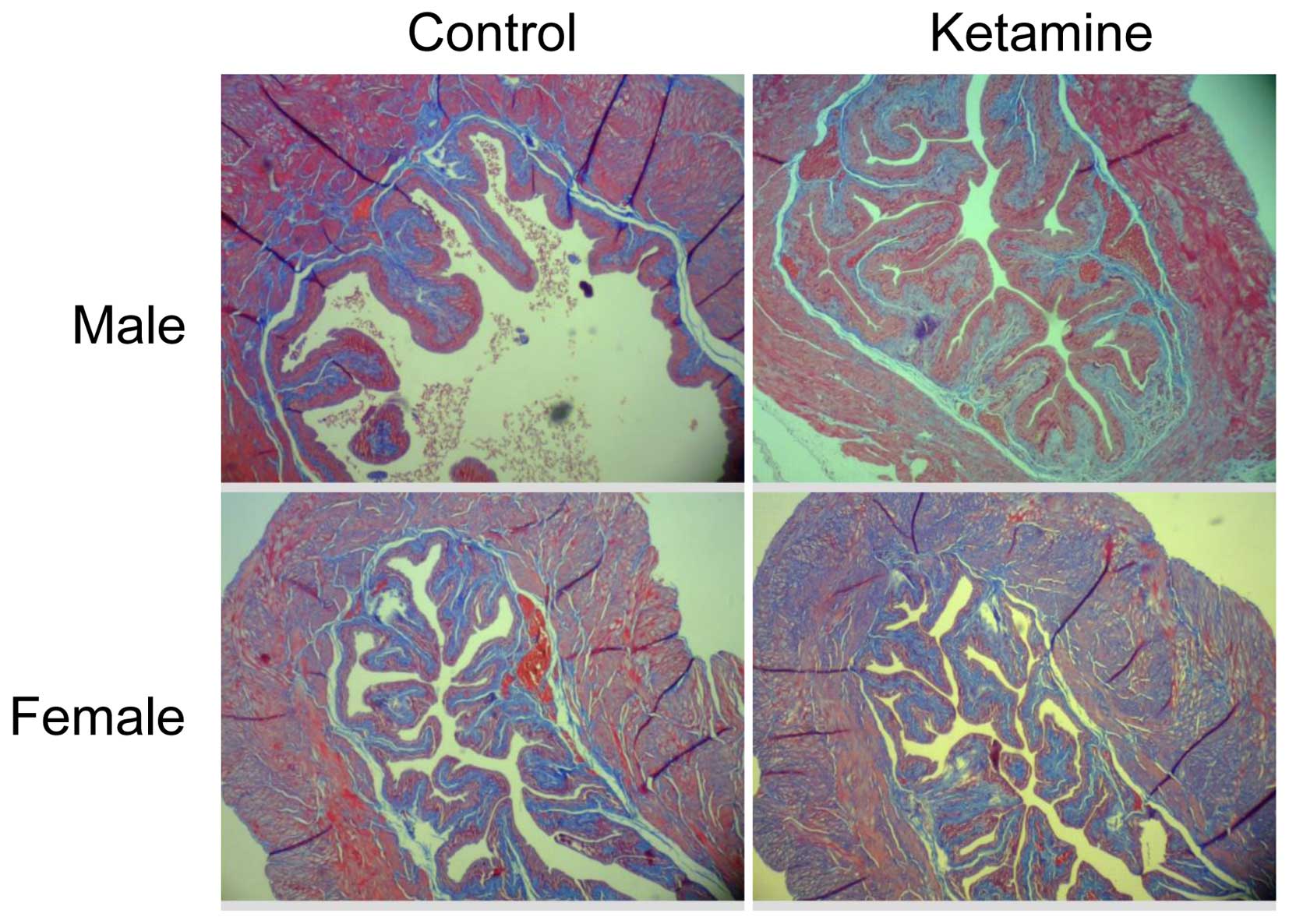Evaluation of urinary bladder fibrogenesis in a mouse model of long-term ketamine injection
- Authors:
- Published online on: July 7, 2016 https://doi.org/10.3892/mmr.2016.5482
- Pages: 1880-1890
-
Copyright: © Shen et al. This is an open access article distributed under the terms of Creative Commons Attribution License.
Abstract
Introduction
Ketamine, a clinical anesthesia, was first synthesized in 1961 (1). Recently, ketamine has become an increasingly popular recreational drug used illicitly by people in clubs or the younger generation. Since the first two clinical case reports about ketamine abuse-induced urological sequelae were published in 2007 (2,3), it has been well-known that long-term ketamine abuse causes side effects that resemble ketamine-associated cystitis (KC), which is associated with severe lower urinary tract symptoms, including smaller bladder capacity, incontinence, dysuria, and hematuria, as well as lower abdominal or suprapubic pain resulting from neurological disorders (4).
To date, the underlying mechanisms of ketamine-induced urinary toxicity remain to be completely understood. However, several hypotheses on the association between ketamine and urinary tract damage have been raised based on clinical observations. The most straightforward and important one points out that ketamine and its metabolites in the urine may have a direct toxic effect on the bladder urothelium, leading to a chronic inflammatory response and subsequent interstitial cystitis-like symptoms (4). In addition, numerous previous studies using rodents for investigating the mechanisms of KC have been reported (5–11). According to the outcome of these previous studies, certain characteristics, such as submucosal infiltration of mononuclear inflammatory cells (5,6) and gene expression, including cyclooxygenase (COX)-2 and inducible nitric oxide synthase (iNOS) (5,7), can link to submucosa inflammatory environment caused by ketamine abuse in clinical cases. Other evidence associated with detrusor over-activity comes from the increase of adenosine triphosphate-evoked detrusor contraction and P2X1 receptor protein observed in Meng et al (8). Alternatively, in Gu's rat model (9), the phosphorylated transgelin of the bladder smooth muscles was increased by ketamine treatment, suggesting that transgelin may have a role in modulating bladder detrusor contractility. Previously, an innovative technique using TGF-β1 injection has also been successfully generated in a reproducible rat model to assess urethral fibrosis (10).
In our previous microarray study, in which male Balb/c mice received 30 mg/kg/day ketamine injection for 2 months, the gene expression of keratin 14, which assembles with keratin 5 to form heterodimers and contribute to the intermediate filament cytoskeleton, was found to markedly decrease in the urothelial tissue (11). This result revealed that the urothelial cells possibly suffered damage from ketamine and likely progressed to a leaked barrier or denuded condition. Therefore, based on the theory of urothelial pathogenesis, it is reasonable to illustrate the effectiveness of intravesical therapy with hyaluronic acid in ketamine-abused patients (12). However, in that study, hematoxylin and eosin (HE) stain analysis revealed no histological difference between the bladders of the control and ketamine-treated mice. Therefore, in the design of the present study, enhanced ketamine dosage (100 mg/kg/day) and prolonged injection period (20 weeks) were administered for both male and female Balb/c mice in order to search for advanced markers associated with the pathogenesis of KC.
Materials and methods
Animals and ketamine treatment
Male and female (n=20 each) 6-week-old Balb/c mice were purchased from the National Laboratory Animal Center (Taipei, Taiwan). All animals were maintained at the qualified animal care facility of Biotechnology and Health Hall in National Chiayi University (Chiayi, Taiwan) for a 1 week period of acclimation. At 7 weeks of age, 10 male and 10 female mice were administered 100 mg/kg ketamine (Merial Laboratoire de Toulouse, Lyon, France) via intraperitoneal injection daily for 20 weeks. A control group of 10 male and 10 female mice were injected with normal saline. All mice were housed in polycarbonate cages, provided with food and water ad libitum and maintained on a 12 h light-dark cycle at 22±2°C. The animal experiment was approved by the Institutional Animal Care and Use Committee of National Chiayi University (no. 102029).
Detection of ketamine and its metabolites in mice urine using gas chromatography-mass spectrometry (GC-MS)
Urine was collected three days prior to the final day of the 20th week. Ketamine and its metabolites were excreted primarily by the kidney, with an elimination half-life of around 2 h in rats (13). The urine from six mice from each group was collected together during a period of 30 min to 4 h following intraperitoneal injection to analyze the concentration of ketamine and its metabolites (norketamine and dehydronorketamine). The collected urine was first filtered using the ultrafiltration Vivaspin 500 device (GE Healthcare Life Sciences, Little Chalfont, UK) with 3 kDa molecular weight cut off achieved by centrifuging at 9,700 × g at 4°C for 30 min. The concentration of ketamine and its metabolites were determined using modified liquid-liquid [triethylamine:cyclohexane, 3:1 (v/v)] extraction, accompanied by GC-MS on a Shimadzu GCMS-QP2010 system (14). The gas chromatograph was equipped with a 30-m DB-5MS (J&W Scientific, Folsom, CA, USA) capillary column with 250 µm I.D. and 0.25 µm film thickness. The injector temperature and GC-MS interface temperature were maintained at 220 and 280°C, respectively. The sample was delivered in splitless mode and the helium carrier gas flow rate was 0.8 ml/min. The temperature of the GC oven was set at 100°C for 0.5 min, then increased to 280°C at 25°C/min and held for 1 min.
Mouse voiding behavior analysis
This analysis was made one day prior to the final day of the 20th week. Urinary voiding quantity and interval were determined using the voided stain on paper (VSOP) method (15). Briefly, the mice were fed with 20 µl/g distilled water. Following waiting for 30 min, the mice were placed on a 25 cm wire-netted grid above a filter paper (Advantec 185 mm; Tokyo Roshi Kaisha, Ltd., Tokyo, Japan). Each mouse was restricted in a certain area matched to a filter paper. Subsequently the voiding time and area were recorded over 2 h. The recorded urine stains were scanned into image files and the stained areas were calculated using the software ImageJ v1.47 (National Institutes of Health, Bethesda, MA, USA). Each voiding interval was calculated based on the time difference between two near voiding episodes. The voiding interval of an individual mouse was the mean of all voiding intervals within a 2 h period.
Mice bladder collection, histological stains and total RNA extraction
Following treatment for 20 weeks, the mice were euthanized by carbon dioxide inhalation and the bladders were removed. A total of 24 bladders (n=6/group) were fixed in 10% neutral formalin for 24 h and then embedded in paraffin and cut into 3 µm sections for preparation of slides used in follow-up histological analysis, which includes HE stain for microvascular location purposes, as well as Masson's trichrome stain to identify collagen distribution. Following staining, these tissue sections were subsequently examined by light microscopy. Furthermore in each group, 2–4 urinary bladders were homogenized individually and the total RNA was extracted using the TRIzol reagent (Thermo Fisher Scientific, Inc., Waltham, MA, USA), according to the manufacturer's instructions. The concentration and purity of the RNA was measured using a NanoDrop 1000 spectrophotometer (Thermo Fisher Scientific, Inc.). Purity was checked using the ratio of the OD260/OD280 and OD260/OD230. The quality of total RNA was accessed using Agilent 2100 Bioanalyzer (Agilent Technologies, Inc., Santa Clara, CA, USA).
Mouse oligonucleotide DNA microarray
The Mouse Whole Genome OneArray® v2 (Phalanx Biotech Group, Hsinchu, Taiwan) contains 27,307 DNA oligonucleotide probes. Each probe is a 60-mer designed in the sense direction. Among the probes, 26,423 probes correspond to the annotated genes in RefSeq v42 (ftp://ftp.ncbi.nlm.nih.gov/refseq/release/release-catalog/archive/release42.files.installed) and Ensembl v59 databases (ftp://ftp.ensembl.org/pub/release-59/fasta/mus_musculus/cdna/Mus_musculus.NCBIM37.59.cdna.all.fa.gz). In addition, 884 control probes were also included. The detailed descriptions of the gene array list are available from http://www.phalanx.com.tw/products/MOA.php.
Microarray analysis
Fluorescent aRNA targets were prepared from 1 µg total RNA samples using OneArray® Amino Allyl aRNA Amplification kit (Phalanx Biotech Group) and Cy5 dye (GE Healthcare Life Sciences). Fluorescent targets were hybridized to the Mouse Whole Genome OneArray® with Phalanx hybridization buffer using Phalanx Hybridization system. After 16 h hybridization, non-specific binding targets were removed using saline and sodium citrate buffer. The slides were scanned using a DNA Microarray Scanner (Model G2505C; Agilent Technologies, Inc.). The Cy5 fluorescent intensities of each spot were analyzed using GenePix 4.1 software (Molecular Devices, LLC, Sunnyvale,. CA, USA). Each single sample was at least assessed twice in terms of technical or biological replicates under the reproducibility >0.975. The signal intensity was loaded into Rosetta Resolver system® (Rosetta Biosoftware, Seattle, WA, USA) for data pre-processing and 75 percentile centering normalization was applied. The errors of the sample were estimated by using the error-weighted approach at the same time. The fold change and P-value for pair-wise sample comparison were calculated for evaluating differentially expressed genes (DEGs). The criteria with log2|fold change|≥0.5 and P<0.05 were used for further analysis.
Reverse transcription-quantitative polymerase chain reaction (RT-qPCR) analysis
In the present study, two genes [Collagen α-1 (III) chain (Col3a1) and Collagen α-2 (I) chain (Col1a2)] were selectively targeted. Each reaction included 20 ng cDNA, 500 nM forward and reverse primers, and 2X Fast SYBR Green PCR Master mix (Applied Biosystems; Thermo Fisher Scientific, Inc.). A total of 10 µl reaction volumes were used for qPCR with the specific primers listed as follows: Col1a2, forward: 5′-TGG CTT CTG ACT ATC TTC CACAG-3′ and reverse: 5′-CAG TTC GTG TCA GCC TTGGT-3′; Col3a1, forward: 5′-GCA ACG GTC ATA CTC ATT CACC-3′ and reverse: 5′-GTT CTG ACC AGT TGA GGT AGTT-3′; Actb reference gene, forward: 5′-GTCCACCTTCCAGCAGATGT-3′ and reverse: 5′-CTCAGTAACAGTCCGCCTAGAA-3′. Each sample was tested in triplicate. The Bio-Rad CFX Connect (Bio-Rad Laboratories, Inc., Hercules, CA, USA) real-time PCR machine and Bio-Rad CFX Manager version 3.0 software (Bio-Rad Laboratories, Inc.) were used for the experimental setup and data analysis. The qPCR data of the target genes were normalized against the reference gene, Actb.
Gene pathway building
To interpret the biological functions of the DEGs between the control and ketamine-treated groups, Gene Ontology (GO) enrichment analysis was used to explore the functional distribution. Additionally, the Kyoto Encyclopedia of Genes and Genomes (KEGG) database was applied to analyze the DEGs to identify essential pathways involved in the microarray data.
Statistical analysis
Statistical differences were analyzed using one-way analysis of variance analysis, with the exception of the microarray data. All statistics were calculated using SigmaPlot version 12.5 (Systat Software, Inc., San Jose, CA, USA). Data are presented as the mean ± standard error of the mean with the exception of data in Table I, which are expressed as the mean ± standard deviation. P<0.05 was considered to indicate a statistically significant difference.
Results
Effect of ketamine on mouse behavior and body weight
At the dosage of 100 mg/kg/day, it was found that the mice at first displayed excitation within 1 min following ketamine injection. They gradually turned into anesthetic status in ~2 min and lasted for ~30 min. In awakening from the anesthesia, the mice first entered a semi-conscious state for ~10 min and then became fully awake. The rate of weight gain of the ketamine-treated mice became significantly slower following the second week compared with that of the control mice. This trend continued for the remaining period of the present study (Fig. 1). Additionally, male mice were more obvious than female mice in this regard, indicating that ketamine toxicity likely caused more severe physiological effects on the male mice.
Ketamine concentration and its metabolites in mice urine
The concentrations of ketamine and ketamine metabolites (norketamine and dehydronorketamine) in urine were detected by GC-MS. These three types of urinary concentrations were undetectable in the control groups (Fig. 2). Following calculation using three individual standard curves, the concentrations of ketamine, norketamine and dehydronorketamine in mice urine were determined (Table I). The concentrations of ketamine metabolites were markedly higher compared with the original form of ketamine, which implied that the urinary toxic effects of ketamine may result from the large quantities of ketamine metabolites in the urine.
Effect of ketamine in the voiding behavior of mice
The voiding quantity and micturition interval were recorded within 2 h using the VSOP method. At week 20, the voiding interval of ketamine-treated male mice was found to be significantly smaller compared with that of control male mice, while no change was observed in the female group (Fig. 3). These results indicated that ketamine toxicity may be more serious in male mice under long-term ketamine influence. This phenomenon appeared consistent with the weight loss of the ketamine-treated male mice, which was more apparent compared with that of the ketamine-treated female mice.
DEGs and pathways identified through microarray analysis of mice bladder tissue
To determine the genes and pathways involved in ketamine-induced toxicity on urinary bladder, the total RNA was extracted from the bladders of the 20 week ketamine-treated mice and of the control mice. The bladdes were subsequently analyzed on the Mouse Whole Genome OneArray® v2 microarray chip containing 27,307 probes. The whole microarray data has been deposited in the GEO database (accession number, GSE68539). The standard selection criteria used to identify the DEGs were log2|fold change| ≥0.5 and P<0.05. The male and female mice data were normalized respectively and were included together to do the further calculation. Compared with the control group, 44 upregulated DEGs and 70 downregulated DEGs were identified for the ketamine-treated mice. To interpret the biological functions of the DEGs, GO enrichment analysis, which provides a common descriptive framework and functional annotation of gene sets data, was performed to examine the functional distributions and classification of the gene sets belonging to male and female mice individually. The GO categories were separated into three groups: Biological process, cellular component and molecular function. The top 15 enriched GO terms of the three categories are shown in Table II. The GO enrichment analysis revealed that genes coding for signaling transduction, likely concerned with the extracellular matrix (ECM) components and cell membrane receptors, serve relevant roles. KEGG pathway enrichment analysis was also performed to identify the essential pathways. From the results, cytokine/chemokine- and ECM function-associated information were much more prominent (Table III).
Expression changes of genes associated with fibrosis
After checking the essential DEGs in detail, the present study listed certain critical genes that are all associated with connective tissue fibrogenesis (Table IV). Notably among them, two collagen genes, Col3a1 and Col1a2 that encoded proteins highly associated with bladder fibrotic diseases (16), were upregulated. Additionally, the remaining genes obviously served as growth factors [e.g. Amphiregulin (Areg)], cytokines/chemokine [e.g. C-C chemokine receptor type (Ccr)2 and Chemokine (C-C motif) ligand (Ccl)7], or that they serve a role in cell mobility [e.g. Collagen triple helix repeat containing 1 (Cthrc1)], ECM remodeling [e.g. A disintegrin-like and metallopeptidase with thrombospondin type 1 motif, (Adamts)1] or angiogenesis [e.g. Platelet/endothelial cell adhesion molecule (Pecam)1 and endothelin 1], which were all directly or indirectly involved in the progression of wound healing and development into plausible chronic fibrosis. Taken together, the presence of type I and III collagens accumulating together with the DEGs in Table IV is highly indicative of the tendency for fibrogenesis and may have a marked association with the effects of ketamine. Furthermore, the expression levels of Col3a1 and Col1a2 were confirmed by RT-qPCR, which was consistent with the microarray data and revealed that ketamine treatment increased their gene expression levels (Fig. 4).
Effect of ketamine in bladder angiogenesis and fibrosis by histopathological analysis
Since two angiogenesis-associated genes were found to be upregulated in the result of microarray analysis, the bladder HE stain was used to confirm the vessel distribution. When compared with the control mice, the ketamine-injected mice exhibited prominently denser blood vessel distribution in the submucosal layer (Fig. 5). According to the increase in blood vessel number, it fits with the biological results of angiogenic factors found in the DEGs of the present microarray data. The present study also verified the collagen density by Masson's trichrome stain analysis (Fig. 6). However, it revealed no obvious increase of collagen accumulation in the submucosa region between the ketamine-treated with control groups due to the similar ratio calculated using ImageJ from connective tissue area relative to muscle tissue or urothelial layer area (data not shown). This result indicated that the progression of fibrogenesis likely remained at the initial stage.
Discussion
In the present study, a 20 week ketamine-injection mouse model was used to characterize the effects of long-term ketamine abuse on bladders by examining critical changes of gene expression. The aim was to explore the mechanisms for clinical management or therapeutic development. Through GC-MS quantification, high concentrations of ketamine and its metabolites were present in mice urine following injection (Table I and Fig. 2). In addition, after 2 weeks of ketamine treatment, the body weight of the ketamine-treated group was significantly lower compared with the control mice. This phenomenon may result from reduced food consumption, similar to the loss of appetite and weight shown in human abusers (17), as well as in animals (8). Additionally, the presence of decreased body weight may likely reflect the physiological stress suffered from ketamine treatment. Notably, the body weight loss and voiding behavior change in the ketamine-treated male mice were more obvious compared with that in female mice. This result may be associated with the higher concentration of ketamine and norketamine measured in the urine of male group (Table I). However, other factors related to mouse gender, including the difference in hormone or metabolic enzymes, may also serve a role and require future investigation. In addition, from the microarray analysis, the most obvious clues come from the upregulated type I (Col1a2) and III (Col3a1) collagens (Table IV and Fig. 4), since their enriched transcription has been considered sensitive markers of active fibrogenesis (18,19). To date, the pathological cause of fibrosis affected by ketamine toxicity remains to be completely elucidated.
In general, fibrosis originates from an abnormal wound healing process in which tissue repair is deregulated as a result of excessive ECM accumulation. According to the classical model of wound healing, the cellular course of events can be divided into certain sequential, yet overlapping phases, including inflammatory, proliferative and tissue remodeling stages (20,21). During the proliferation phase in particular, if the production of pro-inflammatory cytokines/chemokines and growth factors by parenchymal cells is persistent, the ongoing ECM production will eventually destroy the normal balance between collagen formation and degradation (22). In this context, it was revealed that several chemokines and corresponding receptor, including Ccr2, Ccl7 and Ccbp2, were involved (Table IV). Ccr2 has been reported to initiate the fibrotic environment in the liver and lung (23,24). Similarly, overexpressed Ccl7 in fibroblasts also contributes to excessive accumulation of the ECM (25). By contrast, Ccbp2 is hypothesized to act as a chemokine scavenger to counteract the function of Ccl2 (26). Notably, the expression of Ccbp2 simultaneously decreased in the present results. Additional clues come from the increased expression of growth factor-like molecule endothelin-1, since accumulating evidence has suggested that endothelin-1 would result in fibrogenesis via an autocrine loop (27), which drives fibroblast activation, proliferation, as well as differentiation into myofibroblasts thus leading to excessive collagen deposition (28). Another pivotal anti-fibrotic factor, Alox15, which is the key enzyme for the synthesis of lipoxins, can counteract fibroblast activation and experimental fibrosis (29). Notably, in the present data, Alox15 remains on the negative expression list.
Wound healing is a dynamic and complex process that requires cooperative regulation of angiogenesis and cell migration capacity (20). Angiogenesis is essential in wound healing progression for the provision of oxygen and nutrients to the associated fibroblasts and for the transportation of blood-borne precursor cells to the healing area (30). To this point, the upregulation of Pecam1 (CD31) just happens to demonstrate the abundant formation of blood vessels and correlates with the result of the HE staining. By contrast, the lower expression of Cxcl14, a potent inhibitor of angiogenesis based on its ability to inhibit endothelial cell chemotaxis, is likely to facilitate neovascularization as well (31). Apart from them, two upregulated growth factor-like molecules, Areg and Cthrc1 (Collagen triple helix repeat-containing protein 1), also have the high potential to correlate with angiogenesis and cell migration. For example, Cthrc1 can trigger Wnt signaling, which in turn induces subsequent angiogenic program or promotes migratory ability (32,33). Areg belongs to the epidermal growth factor family and is able to mediate transforming growth factor-β-induced pulmonary fibrosis (34). There is also evidence showing that Areg stimulates cell proliferation and exerts a potent anti-apoptotic effects on isolated fibrogenic cells (35). Another associated candidate in Table IV, Adamts1, which encodes a secreted and matrix-associated zinc metalloendopeptidase, was found to promote shedding of the transmembrane precursors of Areg and activation of the epidermal growth factor pathway (36). Taken together, the present findings suggested that persistent activation of the aforementioned chemokines and growth factors may drive urinary bladder fibrogenesis through angiogenesis and cell migration.
In view of the aforementioned causes coupled to the deregulated wound healing process and excessive mRNA level for collagens, although no obvious occurrence of immune cells infiltration was confirmed, as well as collagen proteins accumulation, it was still concluded that the results of the DEGs clearly demonstrated the existence of fibrogenic actions at an early stage. These findings have important implications of the molecular mechanisms underlying ketamine-induced urinary bladder fibrosis and reveal novel targets for the future development of effective therapies.
Abbreviations:
|
DEG |
differentially expressed genes |
|
GC-MS |
gas chromatography-mass spectrometry |
|
GO |
gene ontology |
|
HE stain |
hematoxylin and eosin stain |
|
KEGG |
Kyoto encyclopedia of genes and genomes |
|
MOA |
mouse oligonucleotide DNA microarray |
|
VSOP |
voided stain on paper |
Acknowledgments
The present study was supported by grants from the National Science Council of the Republic of China, Taiwan (no. NSC101-2320-B-415-002-MY3) and from Chiayi Christian Hospital, Taiwan (no. R102-17).
References
|
Domino EF, Chodoff P and Corssen G: Pharmacologic Effects of Ci-581, a new dissociative anesthetic, in man. Clin Pharmacol Ther. 6:279–291. 1965. View Article : Google Scholar : PubMed/NCBI | |
|
Shahani R, Streutker C, Dickson B and Stewart RJ: Ketamine-associated ulcerative cystitis: A new clinical entity. Urology. 69:810–812. 2007. View Article : Google Scholar : PubMed/NCBI | |
|
Chu PS, Kwok SC, Lam KM, Chu TY, Chan SW, Man CW, Ma WK, Chui KL, Yiu MK, Chan YC, et al: 'Street ketamine'-associated bladder dysfunction: A report of ten cases. Hong Kong Med J. 13:311–313. 2007.PubMed/NCBI | |
|
Chu PS, Ma WK, Wong SC, Chu RW, Cheng CH, Wong S, Tse JM, Lau FL, Yiu MK and Man CW: The destruction of the lower urinary tract by ketamine abuse: A new syndrome? BJU Int. 102:1616–1622. 2008. View Article : Google Scholar : PubMed/NCBI | |
|
Chuang SM, Liu KM, Li YL, Jang MY, Lee HH, Wu WJ, Chang WC, Levin RM and Juan YS: Dual involvements of cyclooxygenase and nitric oxide synthase expressions in ketamine-induced ulcerative cystitis in rat bladder. Neurourol Urodyn. 32:1137–1143. 2013. View Article : Google Scholar : PubMed/NCBI | |
|
Yeung LY, Rudd JA, Lam WP, Mak YT and Yew DT: Mice are prone to kidney pathology after prolonged ketamine addiction. Toxicol Lett. 191:275–278. 2009. View Article : Google Scholar : PubMed/NCBI | |
|
Juan YS, Lee YL, Long CY, Wong JH, Jang MY, Lu JH, Wu WJ, Huang YS, Chang WC and Chuang SM: Translocation of NF-kB and expression of cyclooxygenase-2 are enhanced by ketamine-induced ulcerative cystitis in rat bladder. Am J Pathol. 185:2269–2285. 2015. View Article : Google Scholar : PubMed/NCBI | |
|
Meng E, Chang HY, Chang SY, Sun GH, Yu DS and Cha TL: Involvement of purinergic neurotransmission in ketamine induced bladder dysfunction. J Urol. 186:1134–1141. 2011. View Article : Google Scholar : PubMed/NCBI | |
|
Gu D, Huang J, Shan Z, Yin Y, Zheng S and Wu P: Effects of long-term ketamine administration on rat bladder protein levels: A proteomic investigation using two-dimensional difference gel electrophoresis system. Int J Urol. 20:1024–1031. 2013.PubMed/NCBI | |
|
Sangkum P, Gokce A, Tan RB, Bouljihad M, Kim H, Mandava SH, Saleem SN, Lasker GF, Yafi FA, Abd Elmageed ZY, et al: Transforming growth factor-β1 induced urethral fibrosis in a rat model. J Urol. 194:820–827. 2015. View Article : Google Scholar : PubMed/NCBI | |
|
Shen CH, Wang ST, Lee YR, Liu SY, Li YZ, Wu JD, Chen YJ and Liu YW: Biological effect of ketamine in urothelial cell lines and global gene expression analysis in the bladders of ketamine-injected mice. Mol Med Rep. 11:887–895. 2015. | |
|
Tsai TH, Cha TL, Lin CM, Tsao CW, Tang SH, Chuang FP, Wu ST, Sun GH, Yu DS and Chang SY: Ketamine-associated bladder dysfunction. Int J Urol. 16:826–829. 2009. View Article : Google Scholar : PubMed/NCBI | |
|
Veilleux-Lemieux D, Castel A, Carrier D, Beaudry F and Vachon P: Pharmacokinetics of ketamine and xylazine in young and old Sprague-Dawley rats. J Am Assoc Lab Anim Sci. 52:567–570. 2013.PubMed/NCBI | |
|
Wu CH, Huang MH, Wang SM, Lin CC and Liu RH: Gas chromatography-mass spectrometry analysis of ketamine and its metabolites-a comparative study on the utilization of different derivatization groups. J Chromatogr A. 1157:336–351. 2007. View Article : Google Scholar : PubMed/NCBI | |
|
Sugino Y, Kanematsu A, Hayashi Y, Haga H, Yoshimura N, Yoshimura K and Ogawa O: Voided stain on paper method for analysis of mouse urination. Neurourol Urodyn. 27:548–552. 2008. View Article : Google Scholar : PubMed/NCBI | |
|
Deveaud CM, Macarak EJ, Kucich U, Ewalt DH, Abrams WR and Howard PS: Molecular analysis of collagens in bladder fibrosis. J Urol. 160:1518–1527. 1998. View Article : Google Scholar : PubMed/NCBI | |
|
Corazza O, Assi S and Schifano F: From 'Special K' to 'Special M': The evolution of the recreational use of ketamine and methoxetamine. CNS Neurosci Ther. 19:454–460. 2013. View Article : Google Scholar : PubMed/NCBI | |
|
Reyes-Gordillo K, Shah R, Arellanes-Robledo J, Hernández-Nazara Z, Rincón-Sánchez AR, Inagaki Y, Rojkind M and Lakshman MR: Mechanisms of action of acetaldehyde in the up-regulation of the human α2(I) collagen gene in hepatic stellate cells: Key roles of Ski, SMAD3, SMAD4, and SMAD7. Am J Pathol. 184:1458–1467. 2014. View Article : Google Scholar : PubMed/NCBI | |
|
Wong L, Hutson PR and Bushman W: Prostatic inflammation induces fibrosis in a mouse model of chronic bacterial infection. PloS One. 9:e1007702014. View Article : Google Scholar : PubMed/NCBI | |
|
Stadelmann WK, Digenis AG and Tobin GR: Physiology and healing dynamics of chronic cutaneous wounds. Am J Surg. 176(Suppl 2A): S26–S38. 1998. View Article : Google Scholar | |
|
Broughton G II, Janis JE and Attinger CE: The basic science of wound healing. Plast Reconstr Surg. 117(Suppl 7): S12–S34. 2006. View Article : Google Scholar | |
|
Zeisberg M and Kalluri R: Cellular mechanisms of tissue fibrosis. 1. Common and organ-specific mechanisms associated with tissue fibrosis. Am J Physiol Cell Physiol. 304:C216–C225. 2013. View Article : Google Scholar : | |
|
Seki E, de Minicis S, Inokuchi S, Taura K, Miyai K, van Rooijen N, Schwabe RF and Brenner DA: CCR2 promotes hepatic fibrosis in mice. Hepatology. 50:185–197. 2009. View Article : Google Scholar : PubMed/NCBI | |
|
Moore BB, Kolodsick JE, Thannickal VJ, Cooke K, Moore TA, Hogaboam C, Wilke CA and Toews GB: CCR2-mediated recruitment of fibrocytes to the alveolar space after fibrotic injury. Am J Pathol. 166:675–684. 2005. View Article : Google Scholar : PubMed/NCBI | |
|
Ong VH, Carulli MT, Xu S, Khan K, Lindahl G, Abraham DJ and Denton CP: Cross-talk between MCP-3 and TGFbeta promotes fibroblast collagen biosynthesis. Exp Cell Res. 315:151–161. 2009. View Article : Google Scholar | |
|
Graham GJ and Locati M: Regulation of the immune and inflammatory responses by the 'atypical' chemokine receptor D6. J Pathol. 229:168–175. 2013. View Article : Google Scholar | |
|
Shi-Wen X, Rodríguez-Pascual F, Lamas S, Holmes A, Howat S, Pearson JD, Dashwood MR, du Bois RM, Denton CP, Black CM, et al: Constitutive ALK5-independent c-Jun N-terminal kinase activation contributes to endothelin-1 overexpression in pulmonary fibrosis: Evidence of an autocrine endothelin loop operating through the endothelin A and B receptors. Mol Cell Biol. 26:5518–5527. 2006. View Article : Google Scholar : PubMed/NCBI | |
|
Swigris JJ and Brown KK: The role of endothelin-1 in the pathogenesis of idiopathic pulmonary fibrosis. BioDrugs. 24:49–54. 2010. View Article : Google Scholar : PubMed/NCBI | |
|
Krönke G, Reich N, Scholtysek C, Akhmetshina A, Uderhardt S, Zerr P, Palumbo K, Lang V, Dees C, Distler O, et al: The 12/15-lipoxygenase pathway counteracts fibroblast activation and experimental fibrosis. Ann Rheum Dis. 71:1081–1087. 2012. View Article : Google Scholar : PubMed/NCBI | |
|
Tonnesen MG, Feng X and Clark RA: Angiogenesis in wound healing. J Investig Dermatol Symp Proc. 5:40–46. 2000. View Article : Google Scholar | |
|
Shellenberger TD, Wang M, Gujrati M, Jayakumar A, Strieter RM, Burdick MD, Ioannides CG, Efferson CL, El-Naggar AK, Roberts D, et al: BRAK/CXCL14 is a potent inhibitor of angiogenesis and a chemotactic factor for immature dendritic cells. Cancer Res. 64:8262–8270. 2004. View Article : Google Scholar : PubMed/NCBI | |
|
Ye X, Wang Y, Cahill H, Yu M, Badea TC, Smallwood PM, Peachey NS and Nathans J: Norrin, frizzled-4, and Lrp5 signaling in endothelial cells controls a genetic program for retinal vascularization. Cell. 139:285–298. 2009. View Article : Google Scholar : PubMed/NCBI | |
|
Ma MZ, Zhuang C, Yang XM, Zhang ZZ, Ma H, Zhang WM, You H, Qin W, Gu J, Yang S, et al: CTHRC1 acts as a prognostic factor and promotes invasiveness of gastrointestinal stromal tumors by activating Wnt/PCP-Rho signaling. Neoplasia. 16:265–278. 278.e1–e13. 2014. View Article : Google Scholar : PubMed/NCBI | |
|
Zhou Y, Lee JY, Lee CM, Cho WK, Kang MJ, Koff JL, Yoon PO, Chae J, Park HO, Elias JA and Lee CG: Amphiregulin, an epidermal growth factor receptor ligand, plays an essential role in the pathogenesis of transforming growth factor-β-induced pulmonary fibrosis. J Biol Chem. 287:41991–42000. 2012. View Article : Google Scholar : PubMed/NCBI | |
|
Perugorria MJ, Latasa MU, Nicou A, Cartagena-Lirola H, Castillo J, Goñi S, Vespasiani-Gentilucci U, Zagami MG, Lotersztajn S, Prieto J, et al: The epidermal growth factor receptor ligand amphiregulin participates in the development of mouse liver fibrosis. Hepatology. 48:1251–1261. 2008. View Article : Google Scholar : PubMed/NCBI | |
|
Liu YJ, Xu Y and Yu Q: Full-length ADAMTS-1 and the ADAMTS-1 fragments display pro- and antimetastatic activity, respectively. Oncogene. 25:2452–2467. 2006. View Article : Google Scholar |



